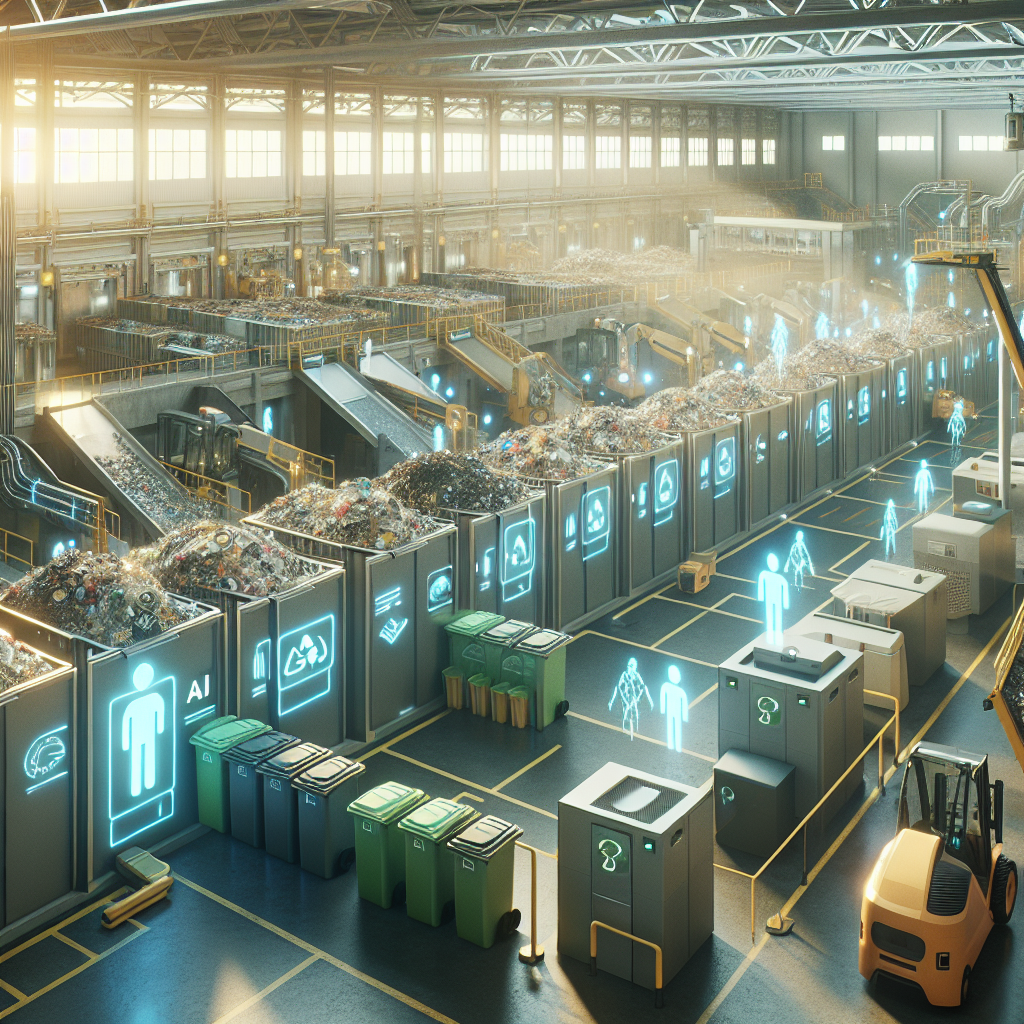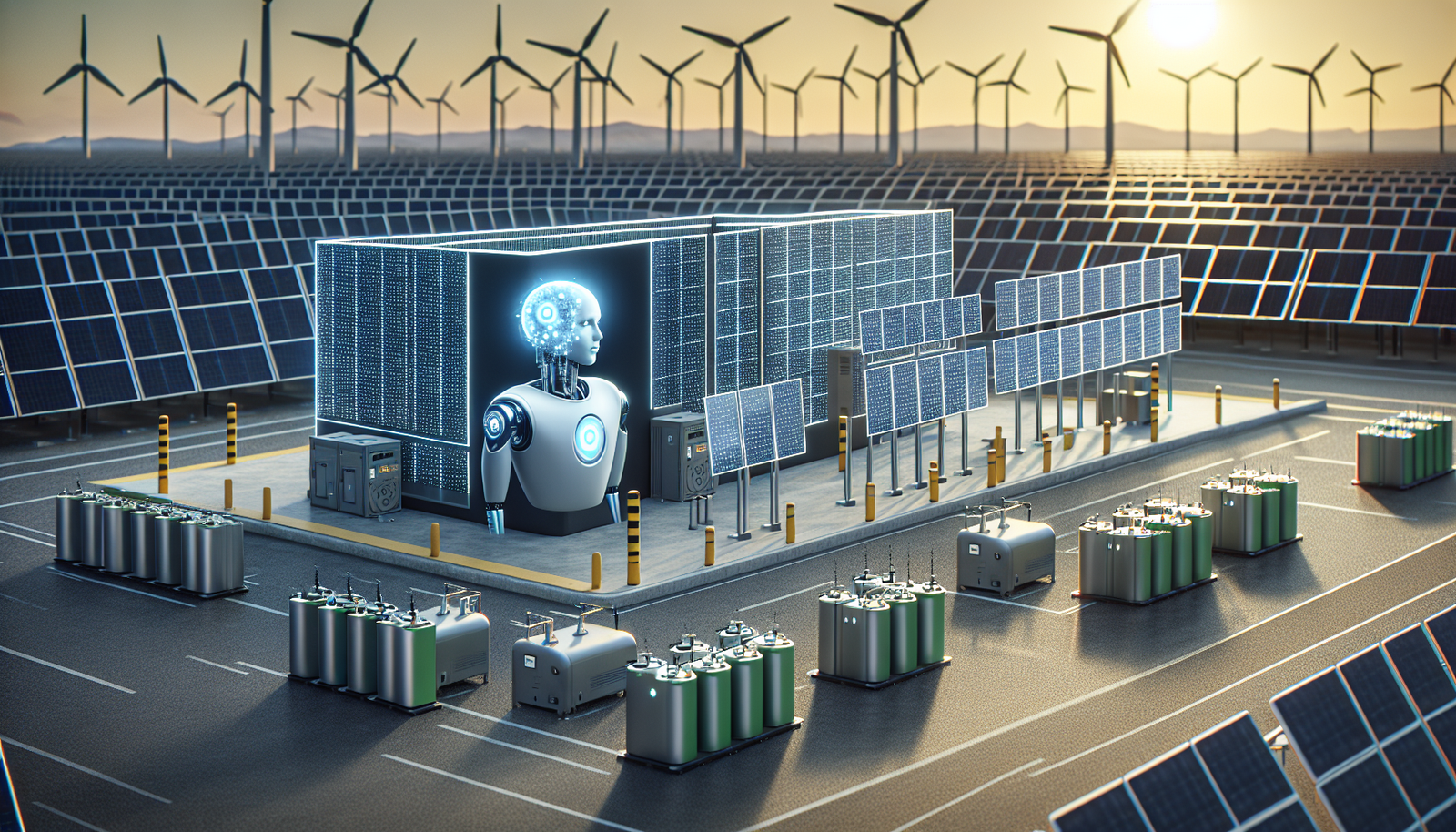The Role of AI in Waste Segregation
Artificial Intelligence (AI) plays a pivotal role in modernizing waste segregation, a critical component of sustainable waste management. By leveraging advanced machine learning algorithms and computer vision, AI systems can efficiently and accurately sort various types of waste materials. These systems are designed to identify different categories of waste, such as plastics, metals, paper, and organic matter, with high precision. This technological advancement significantly reduces human error and labor costs associated with traditional waste sorting methods.
AI-driven waste segregation systems are equipped with state-of-the-art sensors and cameras that capture images of waste items on a conveyor belt. These images are then analyzed in real-time by AI models trained on extensive datasets, allowing the system to classify and sort waste items based on their material composition. This process not only accelerates the sorting process but also enhances the purity of recyclables, thereby increasing the overall efficiency of recycling operations.
| Benefits of AI in Waste Segregation |
|---|
|
Moreover, AI technologies can adapt and evolve over time, learning from new data inputs to improve their sorting capabilities. This adaptability ensures that AI systems remain effective in the face of changing waste streams and recycling standards. Through AI-powered waste segregation, we can achieve significant strides towards a circular economy, where materials are continuously reused, and waste generation is minimized.
AI-Enhanced Recycling Processes
Artificial Intelligence (AI) is revolutionizing recycling processes by introducing advanced technologies that significantly improve efficiency and accuracy. One of the primary ways AI is transforming recycling is through the use of machine learning algorithms that can accurately identify and sort different types of materials. This technology reduces contamination in recycling streams, ensuring that only the correct materials are recycled. As a result, recycling facilities can operate more efficiently, reducing waste and increasing the yield of recyclable materials.
AI-powered robotics are also playing a crucial role in the recycling process. These robots are equipped with sensors and cameras that allow them to recognize various materials and sort them accordingly. The speed and accuracy of AI-driven robots far surpass traditional manual sorting methods. In addition to improving sorting accuracy, these robots can work continuously without fatigue, leading to increased productivity and reduced labor costs.
The implementation of AI in recycling processes is further enhanced by data analytics, which provides valuable insights into waste streams and recycling patterns. By analyzing data collected from recycling operations, AI systems can identify inefficiencies and suggest improvements. This data-driven approach enables recycling facilities to optimize their operations, reduce costs, and improve overall sustainability.
| AI Technology | Application in Recycling | Benefits |
|---|---|---|
| Machine Learning Algorithms | Material Identification and Sorting | Reduces Contamination, Increases Efficiency |
| AI-Powered Robotics | Automated Sorting | Higher Accuracy, Continuous Operation |
| Data Analytics | Operational Insights | Optimization, Cost Reduction |
In conclusion, AI-enhanced recycling processes not only improve the efficiency of recycling operations but also contribute to the broader goals of sustainable waste management. By leveraging AI technologies, recycling facilities can better manage resources, reduce environmental impact, and support the transition towards a circular economy.
Predictive Analytics for Waste Reduction
Predictive analytics is at the forefront of transforming waste management by leveraging data to minimize waste generation and optimize resource use. By analyzing historical data and identifying patterns, AI systems can forecast waste production trends, allowing municipalities and companies to take proactive measures. For instance, AI can predict peak waste generation periods in urban areas, enabling better allocation of resources and scheduling of waste collection services. This proactive approach not only reduces operational costs but also enhances the efficiency of waste management systems.
One of the key advantages of predictive analytics in waste management is its ability to improve recycling rates. By forecasting the types and quantities of waste materials, recycling facilities can adjust their operations to handle specific waste streams more effectively. This targeted approach ensures that recyclables are processed in a timely manner, reducing contamination rates and improving the quality of recycled materials. Additionally, predictive models can help identify potential bottlenecks in the recycling process, allowing facilities to address these issues before they escalate.
Furthermore, predictive analytics plays a crucial role in landfill management. By anticipating the volume and types of waste headed for landfills, operators can optimize landfill space and extend the lifespan of existing sites. AI-driven models can suggest alternative disposal methods or the diversion of certain waste streams to recycling or composting facilities, significantly reducing the environmental impact of landfills. This not only aids in achieving sustainability goals but also supports the transition towards a circular economy.
The following table illustrates the potential impact of predictive analytics on waste reduction:
| Area of Impact | Benefit | Outcome |
|---|---|---|
| Resource Allocation | Optimized scheduling and routing | Reduced operational costs and fuel consumption |
| Recycling Processes | Improved sorting accuracy | Higher quality recycled materials |
| Landfill Management | Extended landfill lifespan | Lower environmental impact |
Smart Waste Collection Systems
Smart waste collection systems are at the forefront of revolutionizing traditional waste management practices. These systems leverage artificial intelligence to optimize the collection routes, reducing operational costs and minimizing environmental impact. By incorporating sensors in waste bins, these systems can monitor fill levels in real-time. This data is then processed using AI algorithms to determine the most efficient collection schedules and routes, ensuring that vehicles only make necessary trips. This approach not only conserves fuel but also reduces the carbon footprint associated with waste collection.
Moreover, smart waste collection systems can significantly enhance urban cleanliness and waste management efficiency. Cities that have implemented these systems report up to a 40% reduction in waste collection costs and a notable decrease in traffic congestion due to fewer collection vehicles on the road. The integration of AI in these systems enables predictive analytics, which can forecast waste generation trends and provide valuable insights for urban planning and resource allocation.
In addition to route optimization, smart waste collection systems support dynamic pricing models that incentivize waste reduction. By analyzing data on waste production and collection, municipalities can implement pricing strategies that encourage recycling and waste minimization. Such models have been shown to reduce overall waste generation by up to 20%, promoting a more sustainable urban environment.
To illustrate the effectiveness of these systems, consider the following data visualization:
| City | Cost Reduction (%) | Traffic Reduction (%) | Waste Reduction (%) |
|---|---|---|---|
| City A | 35% | 15% | 18% |
| City B | 40% | 20% | 22% |
| City C | 30% | 10% | 20% |
This table showcases the tangible benefits that smart waste collection systems offer, underlining their potential to advance sustainable waste management practices in urban areas globally.
AI in Composting and Organic Waste Management
Artificial Intelligence (AI) is playing a transformative role in the management of composting and organic waste. By leveraging advanced algorithms and machine learning, AI systems can efficiently sort and categorize organic waste, optimizing the composting process. This technology not only reduces the time required for waste decomposition but also enhances the quality of the compost produced. AI-driven solutions can analyze data from various sources to identify the most effective composting methods, ensuring that organic waste is processed in the most sustainable manner.
One of the significant advantages of using AI in composting is the ability to monitor and control environmental conditions. Sensors integrated with AI systems can track moisture levels, temperature, and oxygen content, all critical factors in the composting process. By maintaining optimal conditions, AI technologies help in accelerating the breakdown of organic materials. Moreover, AI can predict potential issues such as odor generation or pest infestation, allowing for timely interventions that improve overall efficiency.
In addition to optimizing the composting process, AI technologies assist in reducing contamination in organic waste streams. Advanced image recognition systems can identify and separate non-compostable items from organic waste, ensuring that only suitable materials are processed. This leads to higher quality compost and reduces the risk of pollutants entering the environment. Furthermore, AI systems can provide valuable insights and data analytics to waste management professionals, facilitating better decision-making and strategic planning.
AI-powered solutions also promote community engagement by educating the public and encouraging sustainable practices. Interactive applications and platforms use AI to provide real-time feedback to individuals on their waste disposal habits, suggesting improvements and highlighting the environmental impact of their actions. Through gamification and personalized recommendations, AI can motivate communities to participate actively in composting initiatives, contributing to a more sustainable waste management ecosystem.
AI-Powered Circular Economy Solutions
Artificial Intelligence (AI) is playing a pivotal role in accelerating the transition towards a circular economy, which emphasizes reducing waste, reusing materials, and recycling resources to create a sustainable system. By leveraging AI technologies, companies and municipalities can efficiently manage resources, optimize supply chains, and minimize environmental impacts. One of the core advantages of AI in this domain is its ability to analyze large datasets to identify patterns and make predictions that support circular practices.
AI-driven solutions are enhancing the efficiency of recycling processes by automating sorting systems and improving material recovery rates. Through the integration of machine learning algorithms, waste management facilities can accurately identify and categorize materials, reducing contamination in recycling streams. For instance, AI-powered robots equipped with advanced sensors are now capable of sorting plastics, metals, and paper with remarkable precision. This level of automation not only streamlines operations but also significantly reduces labor costs and human error.
Furthermore, AI is facilitating the design of sustainable products by optimizing resource utilization and minimizing waste production. By analyzing product life cycles and supply chains, AI systems can identify inefficiencies and propose alternatives that align with circular economy principles. Companies are increasingly adopting AI tools to simulate various scenarios, helping them design products that are easier to repair, refurbish, and recycle. As a result, businesses can not only reduce their environmental footprint but also tap into new revenue streams by creating value from waste.
The impact of AI on promoting a circular economy is further illustrated through its role in developing closed-loop systems. These systems aim to keep resources in use for as long as possible, extracting maximum value before recovering and regenerating products at the end of their life cycle. AI enables real-time monitoring and management of these systems, ensuring optimal performance and sustainability. By fostering collaboration between stakeholders, AI-powered platforms can coordinate activities across the supply chain, ensuring that materials flow seamlessly and efficiently from production to recovery.
Optimizing Landfill Management with AI
Artificial Intelligence (AI) is playing a pivotal role in optimizing landfill management, offering innovative solutions that improve efficiency and reduce environmental impact. By harnessing AI technologies, waste management facilities can monitor and manage landfill sites more effectively, ensuring compliance with environmental regulations and enhancing operational productivity. These smart systems utilize sensors and data analytics to provide real-time insights, enabling more informed decision-making and proactive management strategies.
One of the key benefits of AI in landfill management is its ability to predict and manage waste decomposition processes. By analyzing data collected from various sensors, AI systems can forecast gas emissions, leachate production, and other critical parameters. This predictive capability allows landfill operators to implement timely interventions, such as adjusting cover layers or optimizing gas collection systems, thus minimizing environmental risks. Moreover, AI-driven models can optimize the scheduling of waste compaction and cover application, reducing operational costs and extending the landfill’s lifespan.
AI also enhances the accuracy of landfill monitoring through advanced image recognition technologies. Drones equipped with cameras and AI algorithms can survey large landfill areas quickly and efficiently, identifying issues such as unauthorized dumping or erosion. The collected data is processed to generate detailed maps and reports, enabling precise tracking of landfill conditions over time. Additionally, AI systems facilitate automated reporting and compliance verification, reducing the administrative burden on landfill operators and ensuring adherence to environmental standards.
Incorporating AI into landfill management not only optimizes operations but also supports broader sustainability goals. By improving the efficiency of landfill sites, AI contributes to reducing greenhouse gas emissions, minimizing pollution, and conserving valuable land resources. Ultimately, these advancements promote a more sustainable waste management ecosystem, aligning with the principles of a circular economy.
Energy Recovery from Waste Using AI
Energy recovery from waste is increasingly recognized as a crucial component of sustainable waste management strategies. By utilizing advanced artificial intelligence systems, waste-to-energy processes can be significantly optimized, ensuring that the maximum amount of energy is extracted from waste materials. AI algorithms can analyze vast amounts of data from waste streams to identify the most suitable materials for energy recovery, reducing the reliance on fossil fuels and lowering greenhouse gas emissions.
AI facilitates the automation of sorting processes, ensuring that organic and combustible materials are efficiently separated from non-recyclable waste. This not only enhances the efficiency of energy recovery facilities but also minimizes the volume of waste sent to landfills. By using machine learning models, AI can predict and adjust to fluctuations in waste composition, allowing for real-time modifications to the energy recovery process. This adaptability leads to a more consistent and reliable production of energy, contributing to a more sustainable energy grid.
Moreover, AI-powered systems provide valuable insights into the performance of energy recovery technologies. Through predictive maintenance, AI can anticipate equipment failures and schedule timely interventions, reducing downtime and maintenance costs. This ensures a continuous, uninterrupted energy generation process. The following table illustrates the impact of AI on key performance metrics in waste-to-energy facilities:
| Performance Metric | Without AI | With AI |
|---|---|---|
| Energy Efficiency | 65% | 80% |
| Downtime | 15% | 5% |
| Operational Costs | High | Moderate |
In conclusion, the integration of AI technologies in energy recovery from waste not only enhances the sustainability of waste management systems but also aligns with global energy goals. As AI continues to evolve, its role in optimizing waste-to-energy processes will become even more pronounced, offering a promising pathway towards a circular economy.
AI-Driven Community Engagement for Waste Reduction
Artificial Intelligence (AI) is playing a crucial role in transforming how communities engage with waste reduction initiatives. By leveraging AI technologies, municipalities and organizations can personalize waste management strategies and enhance community participation. AI-driven platforms can analyze community waste patterns and provide insights into the most effective methods for reducing waste at the source. This not only helps in tailoring educational campaigns but also in implementing reward systems for households and businesses that actively participate in waste reduction efforts.
One of the primary benefits of using AI in community engagement is the ability to provide real-time feedback and recommendations. For instance, AI systems can be integrated with smart bins that automatically sort recyclables and provide instant feedback to users about contamination levels or recycling errors. These systems can also track individual or community performance over time, offering data-driven insights that encourage more sustainable behaviors. Furthermore, AI-powered applications can gamify the waste reduction process, creating challenges and leaderboards that motivate community members to compete in reducing waste.
AI technologies also facilitate better communication and collaboration among stakeholders involved in waste management. By utilizing AI-driven analytics, city planners and waste management companies can identify trends and areas that require immediate attention, such as neighborhoods with low recycling rates or high contamination levels. This data can be presented in user-friendly formats, such as tables or lists, to help stakeholders make informed decisions. For example, a table can be used to compare waste reduction rates before and after AI intervention:
| Community | Pre-AI Waste Reduction (%) | Post-AI Waste Reduction (%) |
|---|---|---|
| Community A | 15% | 35% |
| Community B | 10% | 30% |
| Community C | 5% | 25% |
Overall, AI-driven community engagement initiatives are proving to be effective in fostering a culture of sustainability and responsibility. As AI technologies continue to evolve, their integration into community waste management efforts is expected to grow, further enhancing the impact of sustainable waste management solutions.
AI and Policy Development in Waste Management
AI is playing an increasingly pivotal role in shaping policy development within the waste management sector. By leveraging data-driven insights, AI technologies enable policymakers to craft more effective regulations that promote sustainability. The integration of AI systems allows for the analysis of vast amounts of data related to waste generation patterns, recycling rates, and environmental impacts, thereby informing more targeted and efficient waste management policies.
Challenges and Opportunities: One of the key challenges in policy development is the lack of comprehensive data. AI helps bridge this gap by providing a detailed analysis of waste streams and identifying potential areas for improvement. For instance, AI algorithms can predict future waste trends, allowing policymakers to proactively address potential issues before they become critical. This proactive approach not only enhances the efficiency of waste management systems but also supports the transition towards a more circular economy.
Impact on Recycling Policies: AI’s influence extends to the creation of more robust recycling policies. By analyzing data from various recycling facilities, AI can identify inefficiencies and recommend policy adjustments to improve recycling rates. For example, AI can pinpoint regions with low recycling participation and suggest targeted educational campaigns to increase public awareness and engagement. This data-driven approach ensures that recycling policies are not only effective but also adaptable to changing circumstances.
The implementation of AI in policy development also facilitates better resource allocation. By predicting areas with the highest waste output, AI enables government agencies to allocate resources more efficiently, ensuring that high-impact areas receive the attention and funding they require. Furthermore, AI-driven policy development encourages collaboration between public and private sectors, fostering innovation and the adoption of best practices across the industry.
Challenges and Ethical Considerations
The integration of AI in waste management introduces several challenges and ethical considerations that need to be addressed to ensure sustainable and equitable solutions. Firstly, the deployment of AI technologies in waste management requires significant investment in infrastructure and training. Many regions, particularly in developing countries, may lack the necessary resources to implement these technologies effectively. This disparity raises concerns about the equitable distribution of technology and benefits, potentially exacerbating global inequalities in waste management capabilities.
Moreover, there is an inherent risk of bias in AI algorithms, which can lead to unfair treatment of certain communities. If AI systems are trained on biased data, they may inadvertently prioritize waste management efforts in more affluent areas, neglecting underserved communities that may suffer from inadequate waste disposal and recycling facilities. It is crucial to ensure that AI systems are designed with fairness and inclusivity in mind, utilizing diverse datasets and involving local communities in the decision-making processes.
Another ethical consideration is the impact of AI-driven waste management on employment. As AI systems become more capable of handling tasks traditionally performed by human workers, there may be job displacement in the waste management sector. It is essential to implement strategies that support workforce transition, such as retraining programs and the creation of new job opportunities in AI maintenance and oversight. Balancing technological advancement with human-centric approaches is key to addressing the ethical implications of AI in waste management.
Data privacy and security are also significant concerns when implementing AI in waste management. The use of sensors and data analytics to monitor waste can result in the collection of sensitive information. Ensuring the protection of individual and community data must be a priority to maintain trust and compliance with privacy regulations. Implementing robust data security measures and transparency in data usage can help mitigate these concerns. As AI continues to revolutionize waste management, addressing these challenges and ethical considerations is essential to achieving sustainable and responsible solutions.
Future Prospects of AI in Sustainable Waste Management
The future of AI in sustainable waste management looks promising, with numerous advancements on the horizon. As technology continues to evolve, AI-driven systems are expected to enhance the efficiency and effectiveness of waste management processes. Machine learning algorithms are continually being refined to improve waste sorting accuracy, thus increasing the percentage of recyclables accurately identified and processed. This improvement not only reduces the contamination of recyclable materials but also enhances the overall efficiency of recycling operations.
Furthermore, the integration of Internet of Things (IoT) with AI is anticipated to revolutionize waste collection and monitoring systems. Smart sensors can provide real-time data on waste levels and composition, enabling more responsive and adaptive waste collection routes. This ensures optimal use of resources, reduces fuel consumption, and minimizes the carbon footprint of waste management operations. The table below illustrates potential benefits of AI and IoT integration in waste management:
| Benefit | Impact |
|---|---|
| Optimized Collection Routes | Reduces fuel consumption by 20% |
| Improved Sorting Accuracy | Increases recycling rates by 15% |
| Real-Time Waste Monitoring | Enhances operational efficiency |
Additionally, AI is poised to play a significant role in promoting the circular economy by facilitating closed-loop recycling systems. Advanced AI models can predict the lifecycle of materials and products, enabling the development of sustainable designs and materials that are easier to recycle or repurpose. Predictive analytics can help manufacturers anticipate the availability of recycled materials, thus promoting their use in new products. The potential for AI to support the circular economy is immense, as it not only aids in waste reduction but also in resource conservation.
Looking ahead, the collaboration between AI, policymakers, and industry stakeholders will be crucial in driving sustainable waste management practices. By setting standards and regulations that promote the adoption of AI technologies, governments can ensure that these innovations contribute to environmental sustainability and economic growth. The future of waste management, empowered by AI, holds the promise of a cleaner, more sustainable planet.



